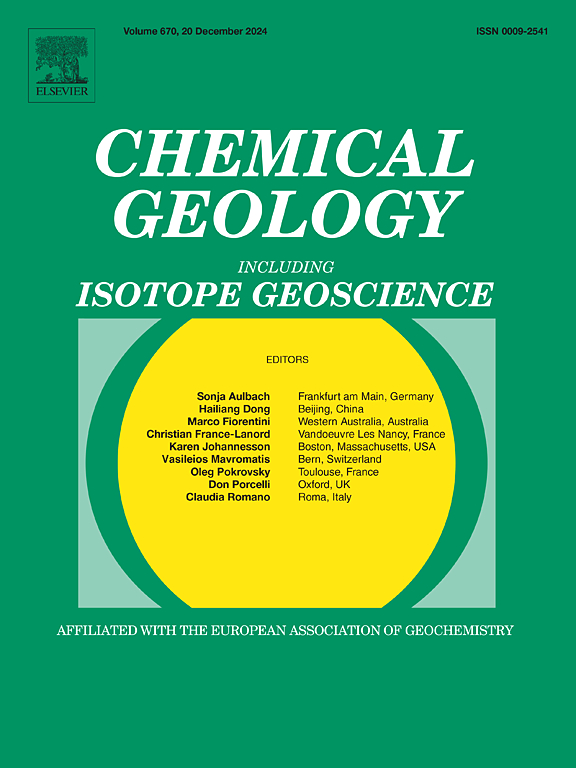Geochemical behaviour of biotite during interaction with aqueous and brine fluids: Constraints from hydrothermal batch experiments
IF 3.6
2区 地球科学
Q1 GEOCHEMISTRY & GEOPHYSICS
引用次数: 0
Abstract
Biotite plays an important role in the geochemical cycle of Li, Rb, Cs, and Ba in the upper continental crust, as it is a significant carrier of Li and large-ion lithophile elements in felsic igneous rocks and high-grade detrital metasedimentary rocks. During its interaction with meteoric and hydrothermal fluids, biotite can be transformed into various types of clay minerals (mostly, interlayer-deficient biotite, vermiculites and smectites). These transformations can cause fractionation of the alkaline trace-element ratios Rb/Li, Cs/Li and Rb/Cs between biotite and its replacement products. This study examines the mineral transformations that occur when biotite interacts with aqueous and saline fluids and the poorly understood geochemical behaviour of the resulting phyllosilicates. For this purpose, we performed batch hydrothermal experiments of the interaction of biotite + quartz ± graphite with ultrapure H2O, and 2 M NaCl, 2 M CaCl2 and 1 M NaF brine fluids at 170 °C and 10 bar using Teflon bombs, and at 550 °C and 800 to 1400 bar using autoclave apparatus. At lower-T conditions, biotite was replaced by 2:1 trioctahedral clay minerals (interlayer-deficient biotite, smectite, vermiculite, and other phyllosilicate species with higher interlayer charge) and Fe oxy-hydroxide minerals by coupled dissolution-precipitation mechanisms. At higher-T conditions, these mechanisms caused the transformation of biotite into the mineral assemblages (quartz ± graphite): diopside + anorthite + titanite (CaCl2 brine experiments), albite + ilmenite + clay minerals (NaCl brine experiments), and cryolite + alkali feldspar with albite rimmed by K-feldspar + Fe-oxides (NaF brine experiments). Therefore, a significant reduction of the clay mineral stability in the presence of NaF and CaCl2 brine fluids is inferred. The biotite replacements by phyllosilicates were mostly controlled by the ion exchange of K+ by H+ (or its hydrate state H3O+), hydrated Na+ and Ca2+, and NaF in the interlayer site. Conservation of the total mass and the Si, Al and Mg abundances occurred in most experimental phyllosilicates. However, in the products of the low-T NaF brine ± graphite experiments, the total mass may have a gain of 5.3–11 % assuming Mg conservation. Sc, V, Nb and Ta abundances were also conserved, but a significant fractionation of the Rb/Li, Cs/Li, and Ba/Li ratios occurred in the experimental phyllosilicates. The experiments predict the generation of highly fractionated Rb/Li and Cs/Li phyllosilicates by replacement of biotite during interaction with aqueous fluids and, mostly, NaCl and NaF brine fluids at high-T and low-T conditions, respectively. This demonstrates a key role of biotite in the fractionation of Rb/Li, Cs/Li and Rb/Cs during the hydrothermal alteration of felsic igneous rocks. Conversely, a reversal in the mobility of Li with respect to Rb and Cs occurred in the phyllosilicate products when biotite interacted with NaCl or CaCl2 brine fluids at relatively low-T conditions. These experimental results highlight the key role of biotite-fluid interaction processes in controlling the budget of alkaline trace elements in the continental crust.
生物岩在与水和盐水流体相互作用过程中的地球化学行为:热液批量实验的制约因素
生物岩在上部大陆地壳锂、铷、铯和钡的地球化学循环中发挥着重要作用,因为它是长粒火成岩和高品位碎屑变质岩中锂和大离子亲岩元素的重要载体。在与流体和热液相互作用的过程中,黑云母可转化为各种类型的粘土矿物(主要是层间缺失黑云母、蛭石和烟云母)。这些转化可导致碱性痕量元素比 Rb/Li、Cs/Li 和 Rb/Cs 在生物岩及其置换产物之间的分馏。本研究探讨了生物橄榄岩与水性流体和盐性流体相互作用时发生的矿物转化,以及由此产生的植硅酸盐的地球化学行为,但人们对其了解甚少。为此,我们使用聚四氟乙烯炸弹,在 170 °C、10 巴和 550 °C、800 至 1400 巴条件下,使用高压釜装置,对生物硅石 + 石英 ± 石墨与超纯水、2 M NaCl、2 M CaCl2 和 1 M NaF 盐水的相互作用进行了批量热液实验。在较低的温度条件下,通过溶解-沉淀耦合机制,生物黄铁矿被 2:1 的三八面体粘土矿物(层间缺失的生物黄铁矿、直闪石、蛭石和其他具有较高层间电荷的植硅酸盐种类)和氧化铁-氢氧化物矿物所取代。在较高的 T 条件下,这些机制导致生物硅酸盐转变为矿物组合(石英±石墨):透辉石+阳起石+榍石(CaCl2 盐水实验)、白云石+钛铁矿+粘土矿物(NaCl 盐水实验),以及冰晶石+碱长石,白云石边缘为 K 长石+铁氧化物(NaF 盐水实验)。因此,可以推断粘土矿物在 NaF 和 CaCl2 盐水中的稳定性大大降低。辉绿硅酸盐对斜长石的置换作用主要受 H+(或其水合物状态 H3O+)、水合 Na+、Ca2+ 和层间部位 NaF 对 K+的离子交换控制。大多数实验用植硅酸盐的总质量以及硅、铝和镁丰度都保持不变。然而,在低 T NaF 盐水±石墨实验的产物中,假定镁元素保持不变,总质量可能会增加 5.3-11%。Sc、V、Nb和Ta的丰度也保持不变,但在实验的植硅酸盐中,Rb/Li、Cs/Li和Ba/Li的比率发生了显著的分馏。实验预测,在高T和低T条件下,在与水流体(主要是NaCl和NaF盐水流体)的相互作用过程中,由于生物岩的置换作用,会生成高度分馏的Rb/Li和Cs/Li绿泥石。这表明在长岩火成岩的热液蚀变过程中,生物岩在 Rb/Li、Cs/Li 和 Rb/Cs 的分馏过程中起着关键作用。相反,在相对较低的T条件下,当生物硅酸盐与NaCl或CaCl2盐水流体相互作用时,植硅酸盐产物中Li相对于Rb和Cs的移动性发生了逆转。这些实验结果凸显了生物岩-流体相互作用过程在控制大陆地壳碱性痕量元素预算方面的关键作用。
本文章由计算机程序翻译,如有差异,请以英文原文为准。
求助全文
约1分钟内获得全文
求助全文
来源期刊

Chemical Geology
地学-地球化学与地球物理
CiteScore
7.20
自引率
10.30%
发文量
374
审稿时长
3.6 months
期刊介绍:
Chemical Geology is an international journal that publishes original research papers on isotopic and elemental geochemistry, geochronology and cosmochemistry.
The Journal focuses on chemical processes in igneous, metamorphic, and sedimentary petrology, low- and high-temperature aqueous solutions, biogeochemistry, the environment and cosmochemistry.
Papers that are field, experimentally, or computationally based are appropriate if they are of broad international interest. The Journal generally does not publish papers that are primarily of regional or local interest, or which are primarily focused on remediation and applied geochemistry.
The Journal also welcomes innovative papers dealing with significant analytical advances that are of wide interest in the community and extend significantly beyond the scope of what would be included in the methods section of a standard research paper.
 求助内容:
求助内容: 应助结果提醒方式:
应助结果提醒方式:


